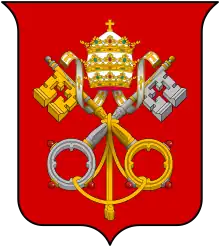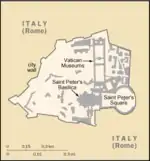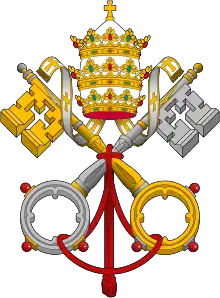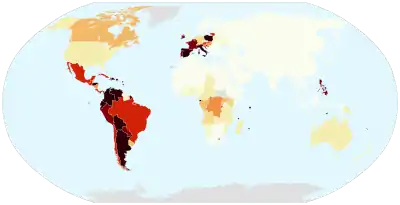Organization of the Holy See and the Vatican State The Bishop of Rome
Holy See Holy See
The Holy See (Latin: Sancta Sedes, "holy seat") is the episcopal see of Rome. The incumbent of the see is the Bishop of Rome — the Pope. The term Holy See, as used in Canon law, also refers to the Pope and the Roman Curia—in effect, the central government of the Catholic Church—and is the sense more widely used today. Although every episcopal see is seen as holy and the Eastern Orthodox Church constantly applies the adjective "holy" or "sacred" (ἱερά) to all its sees, "the Holy See" (in the singular and with the definite article and no other specification) normally refers to the see of Rome, which is also called "the Apostolic See". While "Apostolic See" can refer to any see founded by any of the Apostles, the term is in this case used to refer to the see of the bishop seen as successor of the chief of the Apostles, Saint Peter. The Pope governs the Church through the Roman Curia. The Roman Curia consists of the Secretariat of State, nine Congregations, three Tribunals, 11 Pontifical Councils, and a complex of offices that administer church affairs at the highest level. The Secretariat of State, under the Cardinal Secretary of State, directs and coordinates the Curia. The current incumbent, Tarcisio Cardinal Bertone, is the Holy See's equivalent of a prime minister. Archbishop Dominique Mamberti, Secretary of the Section for Relations With States of the Secretariat of State acts as the Holy See's foreign minister. Bertone and Mamberti have been named in their respective roles under by Pope Benedict XVI in September 2006. Among the most active of the major Curial institutions are the Congregation for the Doctrine of the Faith, which oversees church doctrine; the Congregation for Bishops, which coordinates the appointment of bishops worldwide; the Congregation for the Evangelization of Peoples, which oversees all missionary activities; and the Pontifical Council for Justice and Peace, which deals with international peace and social issues. Three tribunals are responsible for judicial power. The Sacra Rota is responsible for normal appeals, including decrees of nullity for marriages, with the Apostolic Signatura being the administrative court of appeal and highest ecclesiastical court. The Apostolic Penitentiary is different from those two and, instead of dealing with contentious cases, issues absolutions, dispensations, and indulgences. The Prefecture for Economic Affairs coordinates the finances of the Holy See departments and supervises the administration of the Patrimony of the Holy See, an investment fund dating back to the Lateran Pacts. A committee of 15 cardinals, chaired by the Secretary of State, has final oversight authority over all financial matters of the Holy See, including those of the Institute for Works of Religion, the Vatican bank. The Prefecture of the Papal Household is responsible for the organization of the papal household, audiences, and ceremonies (apart from the strictly liturgical part). Like any episcopal see, the Holy See does not dissolve upon the death or resignation of the reigning Pope. It instead operates under a different set of laws sede vacante. During this interregnum, the heads of the dicasteries of the Roman Curia (such as the prefects of congregations) cease to hold office immediately, the only exceptions being the Major Penitentiary, who continues his important role regarding absolutions and dispensations, and the Cardinal Camerlengo, who administers the temporalities (i.e., properties and finances) of the Holy See during this period. The government of the Holy See, and therefore of the Catholic Church, then falls to the College of Cardinals. Canon Law prohibits the College and the Camerlengo from introducing any innovations or novelties in the government of the Church during this period. Vatican City.svg.png.webp) Vatican City
.svg.png.webp) 
Vatican City, officially State of the Vatican City (Latin: Status Civitatis Vaticanae; Italian: Stato della Città del Vaticano), is a landlocked sovereign city-state whose territory consists of a walled enclave within the city of Rome. At approximately 44 hectares (110 acres), it is the smallest independent nation in the world. It was created in 1929 by the Lateran Treaty as a vestige of the much larger Papal States (756 to 1870). Vatican City is a non-hereditary, elected monarchy that is ruled by the Bishop of Rome — the Pope. The highest state functionaries are all clergymen of the Catholic Church. It is the sovereign territory of the Holy See (Latin: Sancta Sedes) and the location of the Apostolic Palace — the Pope's official residence — and the Roman Curia. Thus, while the principal ecclesiastical seat (Cathedral) of the Pope as Bishop of Rome (the Basilica of St. John Lateran) is located outside of its walls, in Rome, Vatican City can be said to be the governmental capital of the Catholic Church. The name "Vatican" is ancient and predates Christianity, coming from the Latin Mons Vaticanus, Vatican Hill. The territory of Vatican City is part of the Mons Vaticanus, and of the adjacent former Vatican Fields where St. Peter's Basilica, the Apostolic Palace, the Sistine Chapel, and museums were built, along with various other buildings. The area was part of the Roman rione of Borgo until 1929. Being separated from the city, on the west bank of the Tiber river, the area was an outcrop of the city that was protected by being included within the walls of Leo IV, and later expanded by the current fortification walls of Paul III/Pius IV/Urban VIII. When the Lateran Treaty of 1929 that gave the state its present form was being prepared, the boundaries of the proposed territory was influenced by the fact that much of it was all but enclosed by this loop. For some tracts of the frontier, there was no wall, but the line of certain buildings supplied part of the boundary, and for a small part of the frontier a modern wall was constructed. The territory included St. Peter's Square, which was not possible to isolate from the rest of Rome, and therefore a largely imaginary border with Italy runs along the outer limit of the square where it touches on Piazza Pio XII and Via Paolo VI. St. Peter's Square is reached through the Via della Conciliazione which runs from the Tiber River to St. Peter's. This grand approach was constructed by Mussolini after the conclusion of the Lateran Treaty. According to the Lateran Treaty, certain properties of the Holy See that are located in Italian territory, most notably Castel Gandolfo and the Patriarchal Basilicas, enjoy extraterritorial status similar to that of foreign embassies. These properties, scattered all over Rome and Italy, house essential offices and institutions necessary to the character and mission of the Holy See. Organization of the Catholic Church Worldwide The worldwide church
|



